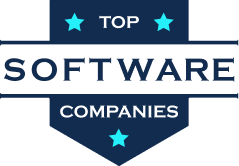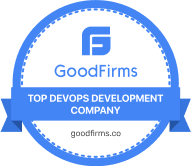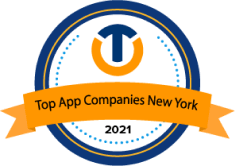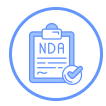The ROI of Power BI: Metrics That Matter to CXOs
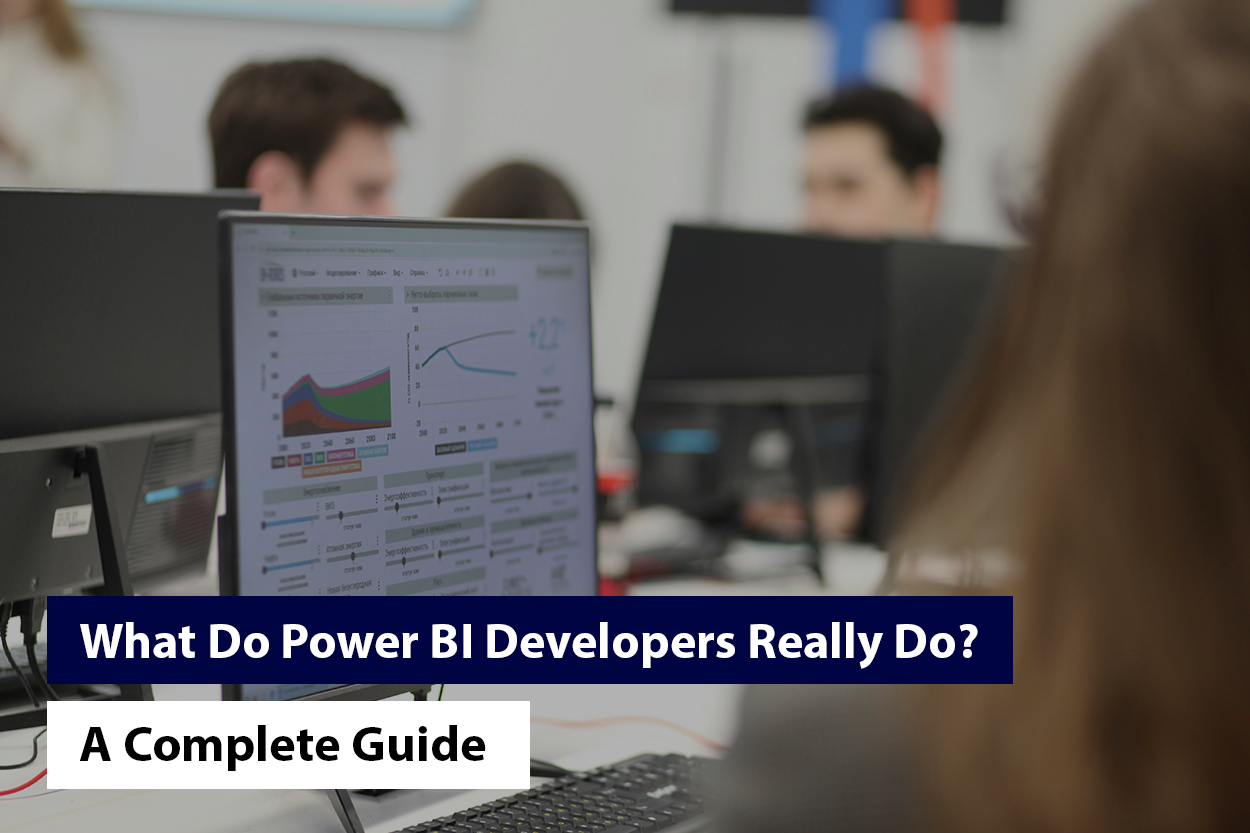
Isn’t it overwhelming to extract meaningful insights from vast amounts of data across multiple sources? But Power BI is a powerful tool that has the potential to help executives transform raw data into actionable insights.
It’s a capital mistake to theorize before one has data
~ Sherlock Holmes
But, now companies need strategic levers such as data-driven IT tools like Microsoft Power BI. They have a great impact on companies, and that metrics do matter to CXOs. From cost efficiency in operation control and strategic business gains, the list has many considerable elements.
Let’s jump into the article and explore every aspect of the ROI of Power BI metrics that truly impact CXOs.
Key Takeaways
- Power BI enables CXOs to make informed and data-driven decisions for strategic growth.
- Real-time insights using Power BI help CXOs identify trends and opportunities swiftly.
- Illustrative visuals and engaging features enhance understanding and actionability.
- Power BI supports seamless integration with third-party tools and data sources.
- Tailored KPIs provide CEOs with essential metrics to monitor performance effectively.
What is the Return on Investment of Power BI?
We are surrounded by data but starved for insights.
~ Jay Baer, marketing and customer experience expert
Today, we are living in a data-saturated world. Here, the true power isn’t in collecting data but converting it into actions. That’s what Power BI helps with. However, CXOs are more concerned about the ultimate ROI of this business intelligence tool.
It is not about a beautiful dashboard but the requirement to make smarter decisions faster and automate slow stuff. This would also help to spot opportunities before a competitor does.
The Key Metrics That Prove Power BI’s ROI to CXOs
Do you agree that the C-level executives need to measure the return on investment from Power BI? And it isn’t just about crunching numbers but about understanding how the tool transforms business operations and drives strategic decisions.
Here are the critical metrics CXOs should track to quantify that value:
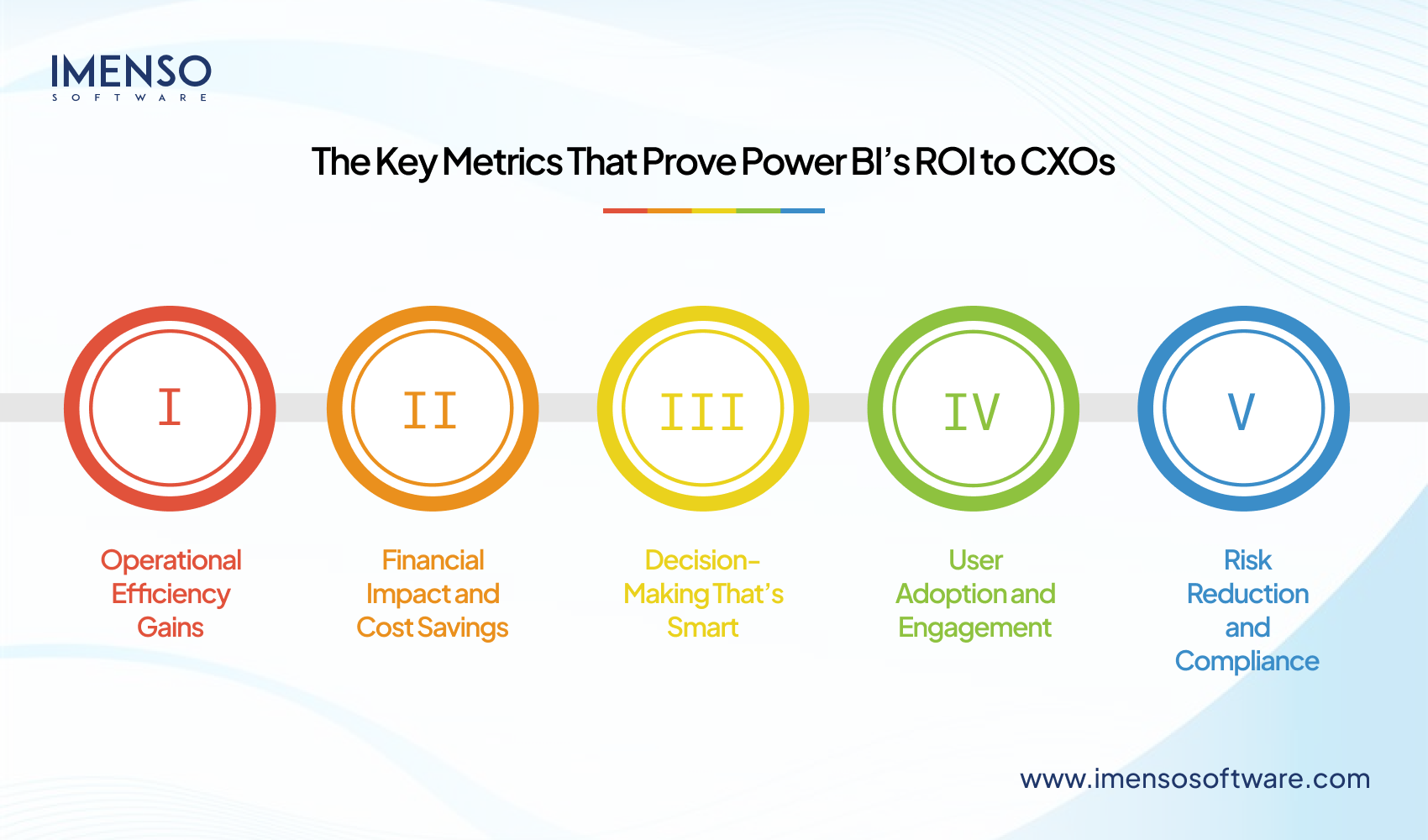
1. Operational Efficiency Gains
What do you think, can Power BI’s automation capabilities streamline many labor-intensive processes?
Well, yes, and it allows teams to spend far less time manually gathering and cleaning. It also allows compelling data from multiple sources. The Power BI’s integration and self-service reporting features allow stakeholders to access live data instantly.
- Time Saved on Reporting: The CXOs often hear about their teams working hard to produce monthly or quarterly reports. The Micosroft Power BI reduces these cycles to just minutes or hours.
For example, a global logistics company reported cutting its weekly report preparation time to just 30 minutes by automating data consolidation and dashboard updates.
- Reduced IT Bottlenecks: Traditional BI tools frequently create heavy dependencies on IT or data teams to generate reports.
- Error Reduction: Automation eliminates many manual data entry errors, which improves data quality and trust essential in decision-making.
Why do CXOs care?
Faster and more reliable reporting accelerates decision-making cycles and boosts overall organizational productivity. This translates directly to cost savings and better business agility.
2. Financial Impact and Cost Savings
Power BI doesn’t just look good on dashboards, infact, it delivers real, bottom-line impact. From cutting software bloat to unlocking smarter revenue strategies, it’s becoming the analytics engine behind boardroom decisions.
- Software Consolidation That Pays Off
Many companies juggle multiple analytics tools, each with its own license fees, training needs, and maintenance headaches. Power BI often replaces all of them with a single, integrated solution.
✅ The result? Big savings. One national retail firm saved over $500,000 a year by retiring legacy BI tools and consolidating licenses under Power BI. That’s half a million dollars back into the business, every year.
- Forecasting You Can Finally Trust
When your data is real-time, clean, and unified, your forecasts stop being guesswork and start being strategic. Finance teams using Power BI build more accurate, data-backed forecasts, helping reduce costly mistakes like overstocking or cash flow gaps.
- Inventory costs drop
- Cash flow improves
- Confidence in planning increases.
- Smarter Revenue Growth with Data-Driven Insights
Sales and marketing teams tap into Power BI to uncover which customers are most likely to convert, what messaging works, and when to strike. That kind of intelligence moves the needle fast.
📌 Companies report revenue uplifts between 5% to 15% just by using Power BI to sharpen customer targeting and campaign timing. That’s not a small bump — it’s a growth accelerator.
Why CXOs Should Care?
This isn’t just a tech story — it’s a business transformation story.
The financial upside of Power BI makes it a strategic investment, not just an IT line item. Whether it’s saving money, increasing efficiency, or driving growth, the value lands squarely in the C-suite’s priorities.
3. Decision-Making That’s Smart
The ability to make quick, confident decisions can make or break a company’s edge in a high-stakes business landscape. Power BI empowers CXOs with real-time visibility, interactive reports, and smart alerts — turning information overload into strategic clarity.
- Faster Decision Cycles
Traditional decision-making often gets bogged down in outdated spreadsheets, delayed reports, and back-and-forth approvals. Power BI cuts through the noise by delivering live dashboards that CXOs can act on instantly.
🏭 Case in point: A major manufacturing firm reduced its operational decision-making time by 80% after adopting Power BI.
- Accuracy That Leadership Can Trust
Bad data leads to bad decisions. Power BI enforces robust data governance, minimizing manual errors and ensuring leaders are always looking at one version of the truth. No second-guessing, no conflicting reports — just reliable insights.
- Empowering Middle Management to Move Faster
Power BI doesn’t just serve the top floor, it empowers frontline managers too. With democratized data access, middle management can make faster, smarter calls without waiting for executive green lights.
This agility creates a culture of accountability and speed across the entire organization.
Why CXOs Should Care?
In business, speed and accuracy provide an advantage. The Power BI equips leaders to spot risks earlier, act on opportunities faster, and outpace competitors in rapidly changing markets. For CXOs, it’s not just about better reports — it’s about better moves at the right moment.
4. User Adoption and Engagement
The ROI of Power BI magnifies when it’s widely adopted across the organization. The goal is not just deployment but active and consistent usage that embeds a data-driven culture.
- Percentage of Active Users: A high ratio of active users versus licenses purchased indicates healthy adoption. For instance, organizations with adoption rates above 70% often see stronger returns.
- Self-Service Analytics Growth: As more business users create and customize their reports, the demand for IT-generated reports declines. This indicates a mature BI culture.
- Training Effectiveness: Training programs improve dashboard usage, reduce errors, and ensure users extract maximum value.
Why do CXOs care?
Broad adoption empowers the entire organization with insights. This drives alignment and collaboration for better decision-making at every level.
5. Risk Reduction and Compliance
Power BI equips CXOs with the insights and oversight they need to proactively manage risks, ensure compliance, and stay audit-ready at all times. After all, data visibility isn’t just a luxury, it’s a necessity.
- Centralized Data Governance
Power BI’s role-based access controls make it easy to share the right data with the right people. So, your sensitive financials, HR data, and operational insights stay secure always. This helps organizations maintain trust and confidentiality.
- Audit Trails & Compliance Made Simple
With built-in audit logs, Power BI tracks who accessed what data and when. This transparency not only streamlines regulatory reporting but also makes compliance less of a headache — especially during audits.
- Reduced Risk Exposure
From financial anomalies to supply chain disruptions, Power BI uses forecasting and data patterns to flag potential risks before they escalate.
Why CXOs Should Care?
Mitigating risk isn’t optional. It protects your brand reputation so you can avoid costly penalties and ensures sustainable growth. Executives get the control they need without slowing the business down with Power BI.
Case Study: R.S. Hughes Transforms Analytics and Achieves Significant ROI with Power BI
Company Overview:
R.S. Hughes is a prominent retail distributor specializing in industrial supplies. The company was facing challenges with fragmented data sources and manual reporting processes. And, this obstructs timely decision-making and operational efficiency in the company.
Major Challenges:
- Data Silos: Disparate data sources made it difficult to obtain a unified view of business metrics.
- Manual Reporting: Legacy systems required extensive manual effort to generate reports. This causes delays and potential errors.
- Limited Real-Time Insights: The existing infrastructure did not support real-time data analysis. It affected responsiveness to market changes, which is a high-risk.
Solution:
R.S. Hughes partnered with JourneyTeam and decided to implement a comprehensive analytics solution to address these concerns. These include to overcome inefficiencies and unlock the full power of their data.
For this, R.S. Hughes rolled out a strategic modernization plan. Here’s how they did it:
- Data Centralization with Azure
They migrated their fragmented systems to Microsoft Azure, using Azure Data Lake Storage and SQL-based resources to centralize all business data in one unified and scalable environment. This became the foundation for all advanced analytics going forward.
- Automated Reporting with Power BI
Manual spreadsheets and static reports became a thing of the past. By automating key reports through Power BI, teams reduced errors, saved time, and ensured stakeholders always had access to up-to-date, accurate information.
- Real-Time Dashboards for Instant Insights
With Power BI, the company developed interactive, real-time dashboards that gave leadership a live window into operations, performance, and KPIs — helping them make faster, better decisions.
✅ Real Results: How Power BI Transformed Decision-Making at R.S. Hughes
Implementing Power BI wasn’t just a tech upgrade — it was a business transformation. Here’s what changed:
- 🚀 Enhanced Decision-Making
With real-time access to unified data, stakeholders were finally able to make quick and confident decisions without waiting on outdated reports or siloed spreadsheets. Decisions that once lagged now drive the business forward.
- Operational Efficiency
By automating reporting processes, the team eliminated manual errors and freed up countless hours previously lost to repetitive data tasks. The result? More time for strategy, less time in Excel.
- 👥 Seamless User Adoption
Change is only successful if people use the tools. R.S. Hughes invested in a structured training program that ensured broad adoption across teams, turning Power BI into an everyday part of decision-making.
📌 Key Takeaways for Leaders

- 1. Strategic Implementation Matters
Pairing Power BI with Azure gave R.S. Hughes the agility to move away from legacy systems with confidence and build a modern analytics foundation that scales.
- 2. It’s More Than Tools — It’s Culture
Analytics tools don’t create a data-driven culture. People do. That’s why focusing on training, communication, and adoption was just as important as the tech itself.
- 3. Build for the Future, Not Just Today
The Power BI + Azure setup wasn’t just a solution for current needs. It created a scalable infrastructure that can evolve with the business, whether it’s growth, new markets, or shifting data priorities.
Leadership Lens: Maximizing ROI with Power BI – CXO Insights & Best Practices
Too often we forget that genius, too, depends upon the data within its reach, that even Archimedes could not have devised Edison’s inventions.
~ Ernest Dimnet, priest, writer, and lecturer
C-suite leaders are no longer just sponsors of analytics—they’re strategic drivers of its success. Power BI isn’t just another reporting tool; it’s a catalyst for smarter, faster, and more profitable decisions. But to unlock its full value, CXOs must look beyond dashboards and focus on what drives ROI.
This section dives into what matters most to executive leadership: the business impact of Power BI and the best practices that ensure success. From operational efficiency to revenue growth and competitive agility, we explore how visionary CXOs are turning insights into action—and action into advantage.
CXO Impact Highlights
Power BI CXO Takeaways and Winning Moves
Power BI isn’t just a tool—it’s a results engine for the entire leadership team. Here’s how top executives are seeing tangible ROI across operations, strategy, and growth:
- CFO: From Spreadsheets to Strategy
Manual report preparation used to eat up time and money. By automating financial reporting with Power BI, the CFO reclaimed 13 hours per week, saving $120,000 annually in labor costs.
Now, instead of compiling data, finance can focus on strategic planning, forecasting, and growth.
- COO: Supply Chain, Supercharged
Real-time visibility into inventory and logistics enabled a 20% boost in forecast accuracy. That accuracy translated into $500,000 in savings, thanks to reduced excess inventory and smarter procurement.
- Sales Director: Smarter Campaigns, Bigger Wins
With on-demand customer insights at their fingertips, the sales team launched more targeted campaigns and boosted quarterly revenue by 3.5%. Power BI turned sales data into sales action.
- CEO: Leadership Powered by Live Dashboards
Previously, decision-making cycles stretched across a week. With daily-refreshed dashboards, the CEO and executive team slashed that lag from 5 days to 1, dramatically improving business agility and response time.
Lessons Learned & Best Practices
Power BI in the Boardroom: Success Tactics
- Data integration is critical: The foundation of success was unifying disparate systems for a “single source of truth.”
- User adoption drives ROI: Investing in training and self-service capabilities tripled dashboard usage, maximizing the platform’s impact.
- Executive sponsorship matters: Active involvement from the C-suite helped prioritize data governance and cross-team collaboration.
- Measure what matters: Tracking key CXO metrics provided clear visibility into Power BI’s financial and operational impact.
For CXOs, the true power of Power BI lies not just in the data it presents, but in the culture it enables. A culture where decisions are driven by evidence. Here, teams are empowered with real-time insights, and leaders can measure progress against strategic goals every single day.
By aligning technology with leadership priorities and following proven best practices, organizations can go beyond adoption and achieve sustained, measurable ROI. For forward-thinking executives, Power BI offers business value highlights and an implementation playbook.
Power BI ROI Isn’t Just Numbers — It’s a Leadership Advantage
If you’re a CXO still flipping through spreadsheets or waiting on monthly reports to make high-stakes decisions, you’re already behind.
Power BI isn’t just another analytics tool, it’s your strategic radar. A crystal-clear lens into what’s happening across finance, operations, sales, and more in real time. And the ROI? It’s not hype. It’s happening.
What Real ROI Looks Like for CXOs?
- Our CFO slashes hours of manual reporting and refocuses on forecasting strategy.
- 📊 Your COO spots supply chain bottlenecks before they spiral into cost blowouts.
- 💼 Your CMO gets campaign performance updates today, not next quarter.
- 🧠 You, as a leader, gain control, clarity, and confidence in every decision.
With Power BI, organizations like TechGear Inc. aren’t just visualizing data — they’re reshaping how leadership works. They’re saving time, boosting margins, and responding to market shifts faster than competitors can blink.
The businesses winning today aren’t just “data-driven.” They’re decision-driven that are powered by real-time insights that serve the boardroom, not just the back office.
So, Power BI makes that possible and profitable.
Frequently Asked Questions
- What is meant by ROI in Power BI?
It refers to the value a business gains from using it. This includes faster access to insights and more accurate decisions, also reduced manual efforts.
- How does investing in Power BI help in the decision-making process?
Power BI brings data together from different departments and presents it. So, it allows decision-makers to quickly understand what’s happening in your business and respond with confidence.
- What is the ROI of business intelligence tools?
This is achieved when your company utilizes data to cut costs effectively and streamline operations. It reduces mistakes and grows revenue in the long run as a result of your investment to these tools.
- What is the main objective of Power BI?
The main objective of business intelligence tools like Power BI is to turn business data into clear and useful information. This ensures that the concerned individuals would get the right insights at the right time for improved decision-making.
- How are Power BI dashboards and reports different from each other?
You can get a real-time over of the key information in one place while working with Power BI dashboard. Also, reports help you have a more detailed analysis, which often has multiple pages of visuals focused on specific areas of the business.
Want more information about our services?
Similar Posts
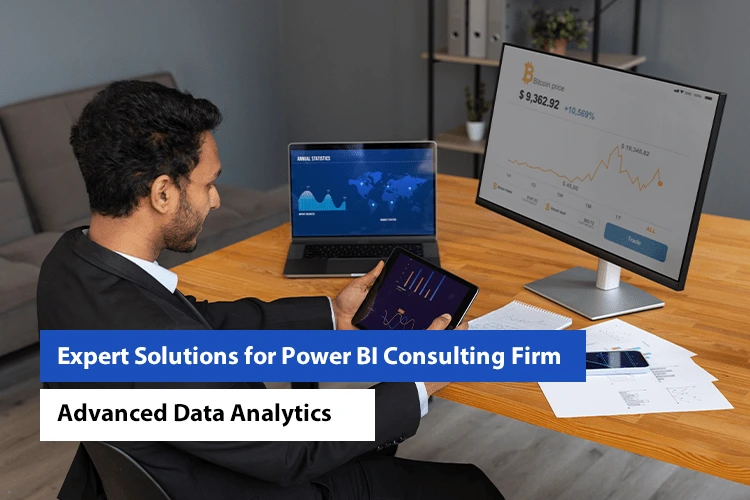
Expert Solutions for Power BI Consulting Firm: Advanced Data Analytics
Businesses depend closely on their ability to accumulate, system, and interpret statistics in contemporary global data-based systems. Data analytics offers crucial insights into client behavior, operational efficiency, and market traits. One of the main systems for remodeling raw information into actionable insights is Power BI. Whether you’re a small startup or a huge company, utilizing […]...

How to Create a Data Culture in Your Organization Using Power BI?
Without data, you’re just another person with an opinion. ~W. Edwards Deming Do you believe that decisions backed by real-time insights are no longer an option? Organizations that invest in building a data culture gain a competitive edge. Also, it improves efficiency and fosters innovation across departments. But creating a data-driven culture needs more than […]...

Power BI Data Modeling Best Practices
The backbone of any strong Business Intelligence tool is data modeling. Believe it or not, many organizations have seen an increase of up to 35% in data accuracy after following proper Power BI data modeling best practices. Among the advanced tools for data visualization, Power BI can let a business unlock the full potential of […]...


